Let’s face it, if your business is not getting a return on investment from its marketing activities, what’s the point of being on social media?
So, how well are you measuring your social media ROI?
According to The Sprout Social Index, Edition XVII: Accelerate report — “Only 15% of marketers use social media data to measure ROI… and social is still treated as a marketing only resource.”
Hard to believe it, right? But it’s true, and we get it!
The main issue regarding social media ROI is the lack of information.
We often hear from clients, “How do you measure social media ROI?”, “What are the metrics I should look for?”, “What is a good social media ROI?”, and so on.
That’s why we have decided to put together this article, to guide you through and help you understand the main metrics you should focus all your attention on.
Let’s get started:
Social Media ROI is purely related to return on investment from your social media activities and expenses.
Table of Contents
What is Social Media ROI (and why does it matter?)
In technical terms, social media ROI is a metric that represents the amount of value generated by the total investment into social media.
In other words, social media ROI is purely related to return on investment from your social media activities and expenses. “It represents the amount of money you have invested into a campaign versus what the business will get from that campaign,” says George Hawwa, Growth Director at Attention Experts.
Typically, ROI is measured as a monetary value. However, in some cases, the impact on revenue is challenging to measure instantly, and sometimes it has to be quantified by non-monetary metrics.
From there, it’s crucial that, before you start a social media campaign, you define what you’re trying to get out of the campaign. Of course, we understand that your main goal is to increase revenue. However, it’s essential to consider that ROI is also the measurement of all the actions that generate value for your company, increase engagement, and drive people to your website or database.
Measuring social media ROI matters because it helps you optimise your marketing strategy. When you measure your campaign performance, you can know in real-time what is working and what isn’t, allowing you to adjust your resources, change tactics and optimise your budget.
What’s The Average ROI for Social Media Marketing?
There is no average ROI for social media marketing or industry.
Let’s say that as soon as your ROI is not negative and it’s more than 0, it means your investment is getting you a return.
A positive ROI relates to different factors, such as;
- Is the company running other marketing campaigns or other channels?
- Do they have a sales team? Is the website optimised?
- Or how long has the campaign been running?
On average, a business can start seeing a return on investment from a social media campaign after 6 to 9 months.
But here is the good news! Once you’ve got a customer, and are able to retain that client again for a long time, that’s a long term ROI.
Before we move on, here’s a simple formula for how to calculate ROI for social media:
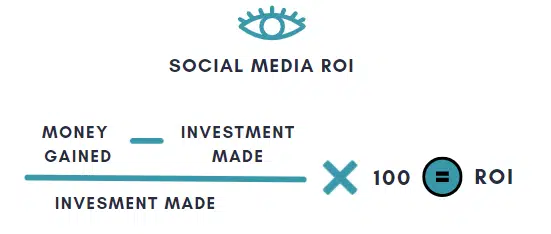
Remember that calculating your ROI depends on your organisation’s objectives (brand value, brand awareness, lead generation, revenue, customer satisfaction and loyalty, etc.).
Breakdown of the Most Important Social Media Metrics for ROI
Metrics, metrics, metrics… How much do you know about it?
Before diving into the most critical metrics for ROI, let’s check out the social media funnel and the relationship with each group of metrics.
The social media funnel represents a customer’s journey from the initial stage, when someone engages with your business, to when they become a customer. Each stage can be measured with its own group of metrics; however, not all metrics indicate that your business is making money.
Stage 1: Awareness
These metrics indicate how many people are aware of your brand.
Stage 2: Engagement
These metrics indicate how your audience is interacting with your brand.
Stage 3: Conversion
These metrics indicate how effective your social engagement is.
Stage 4: Consumer
These metrics indicate how your current clients/customers feel about your brand.
When analysing your social media performance, it’s essential to look at all of the above metrics so you can make adjustments and optimise your campaigns. However, if your goal is to measure your social media ROI, our advice is to focus on conversion and consumer metrics.
Click-Through Rate / CTR
CTR is the total number of clicks your content or an ad receives within a specific period over the number of impressions.
How to measure it:
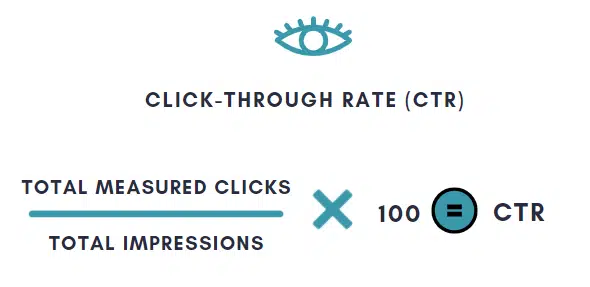
Cost per 1,000 impressions / CPM
CPM is the cost per ‘mille’, also known as the cost you pay for one thousand impressions or views on a sponsored social media post.
How to measure it:
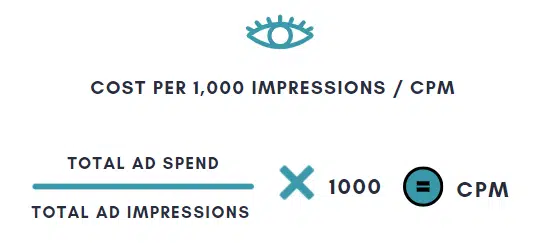
Conversion Rate
It represents the number of people who take action after clicking on the CTA. (Register for a webinar, book a consultation, download a guide, etc.).
How to measure it:
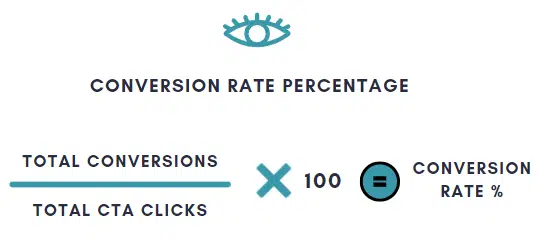
Cost-Per-Click (CPC)
CPC is also called pay per click PPC. It’s the amount you paid per click on an Ad.
How to measure it:
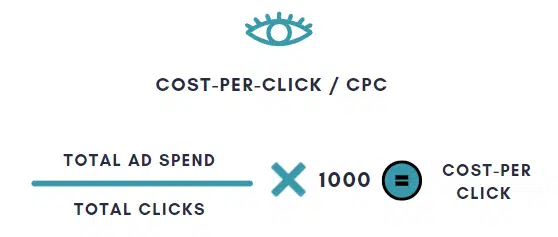
Maximise ROI with These 3 Key Social Media Metrics
The above list could get longer and longer, but measuring all of them is pointless unless paired with your business objective.
The end of a business is to get a return on their investment, so let’s keep focusing on that and explore these three key social media metrics that will help you maximise your budget.
Metric #1- Click Through Rate / CTR
A low CTR is a negative indication that your content does not add value to your audience. The user is not finding the content helpful and relevant. It also means that your campaign is not targeting the right audience.
A good CTR will help your ad reach more people in a faster way. However, keep in mind that a good CTR is relative to what you’re promoting, the format, and the social networks.
“CTR and CPM are like your breakup accelerator. CPM is the amount of petrol that will see your ad and CTR is like how fast or slow it’s going” George Hawwa
Metric #2- Cost per 1,000 impressions / CPM
CPM is pretty much one of the most important metrics you should keep an eye on.
It’s essential because businesses can easily compare the effectiveness of a campaign and different channels, for example, a different CPM between Facebook and LinkedIn, or Google Search vs Facebook Ads.
Check out the differences between Facebook Ads and Google Ads.
The CPM can also compare the effectiveness of an audience or piece of content.
Note that the CPM varies depending on many factors, including location, device, the performance of your organic content and how often the audience engages with your page.
Metric #3- Video Watch Views
Video Watch Views measure the number of people who watch your video. The value of this metric is that a highly viewed video also has a broader reach, which means more people can view the video, giving you greater reach to people outside of your circle.
It will help your campaign build new databases, create custom audiences and instantly attract more people to your social media channels.
Also, consider that if people stop and watch your video for more than three seconds, that means your content is giving value.
How to Make the Social Media Algorithm Work for You Using the Correct Data
The main goal of the Facebook algorithm is to keep people on the platform for longer, and if you do so, Facebook will reward you with more reach, higher CTR and lower CPM.
Here are some quick tips to encourage the algorithm to optimise your social media ROI.
-
Treasure your social media data
Take a look into the insights of each account or beyond your google analytics and understand which types of content are your top performers? What is the best day of the week or time to post? What is the best format? Break down this data for paid and organic campaigns.
Use the data to create your subsequent campaigns and content.
-
Listen and connect with your audience
Social media listening needs to be a part of your strategy. It’s not just about knowing what people say about your brand. It’s also about building a community!
If someone sends a message or leaves a comment, reply as soon as possible. Inspire your audience and keep the conversation going.
-
Run more than one campaign with different goals.
With this, you will help the algorithm understand what you are trying to achieve. For example, are you trying to build a community around your brand, engage with them, or are you trying to sell a product only?
You can create a conversion campaign for a custom audience. From here, the algorithm will know you are trying to reach people who know about your brand already, so the probability that they engage with a video of testimony is higher.
How We Can Help You Increase Social Media ROI
If you’ve read to this point, you’re likely very interested in growing your business through Social Media Marketing.
And if you need help with your social media strategy. You can also give us a call for a FREE Strategy Session. Our number is 1300 809 935 or message or message us on Facebook at www.facebook.com/attentionexperts. You can also book a meeting with us via our website.
About our Growth Director and Founder of Attention Experts:
George is in charge of Attention Experts’ overall growth and best practices. George shares some accolades: being named in the ‘Top 30 leaders under 30’ in 2007 by Entrepreneur Australia Magazine and having won ‘Outstanding Young Entrepreneur of the Year’ for 2018 at the NSW Business Chamber Regional awards.
He also currently lectures at Sydney University on social media strategy to Postgraduate students at the Centre for Continuing Education. In addition, George is a sought after speaker and educator on social media strategy and business.


